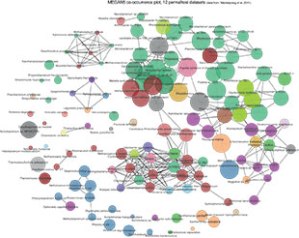This post originally appeared at Emily Monosson's blog: Evolution in a Toxic World
We live in an age of pesticide and antibiotic overuse. One outcome is resistance, increasing pesticide use and contamination and fears that we are entering the “post-antibiotic era”. We are addicted to all sorts of commercial chemicals.
So what’s next? How do we break the cycle? While industry may see opportunities for newer and more powerful chemicals, there’s another way out.
 We need to rethink our strategy. One of the most promising and exciting (the newest-oldest solution) is allying with Nature. The metagenomics boom is bringing to light microbes by the billions. More of them good than “bad.” For over a century, we have narrowed our focus on the pathogens. One disease after another: C. diff, MRSA, Borrelia in our bodies and Late blights, early blights, wilts and rots in our fields. But now agricultural and medical scientists for the first time ever are becoming acquainted with Earth’s microbiome in a big way. The invisible world whose only citizens we’ve come to know were those we could capture and culture. A mere fraction. Now we are getting to know the whole neighborhood. The communities where pathogens mix and mingle with others, where those most likely to run amok are managed by the neighbors. Many produce their own chemicals: small molecules for communication and for protection — antibiotics produced on a microbial scale keeping microbial communities in check. Others simply out-compete otherwise aggressive undesirables.
We need to rethink our strategy. One of the most promising and exciting (the newest-oldest solution) is allying with Nature. The metagenomics boom is bringing to light microbes by the billions. More of them good than “bad.” For over a century, we have narrowed our focus on the pathogens. One disease after another: C. diff, MRSA, Borrelia in our bodies and Late blights, early blights, wilts and rots in our fields. But now agricultural and medical scientists for the first time ever are becoming acquainted with Earth’s microbiome in a big way. The invisible world whose only citizens we’ve come to know were those we could capture and culture. A mere fraction. Now we are getting to know the whole neighborhood. The communities where pathogens mix and mingle with others, where those most likely to run amok are managed by the neighbors. Many produce their own chemicals: small molecules for communication and for protection — antibiotics produced on a microbial scale keeping microbial communities in check. Others simply out-compete otherwise aggressive undesirables.
The rise of C. diff in humans following antibiotic treatment in vulnerable patients and the efficacy of fecal transplants — essentially replacing a gut community bereft of a healthy neighborhood, with a more properly functioning community is one example. While on the farm agriculturists are buzzing about the potential for microbes to wean large conventional growers off of synthetic fertilizers and pesticides (or at least turn the latter into supplementals rather than necessities) is providing a host of other examples from biopesticides to probiotics for the farm. For more about this see The Littlest Farmhands recently published in Science.
We are chemical addicts. Returning to Nature is like going back to the future, with an opportunity to change the timeline. Adjust our course. In the near future perhaps we can rely less on our synthetic chemistry and more on Nature’s capacity to manage her own.


